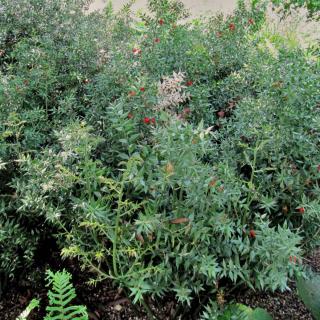

With its cute, well-formed leaves and bright red berries, Butcher’s broom (Ruscus aculeatus) excels at filling in small shrub beds in shady areas.
Basic Butcher’s broom facts
Name – Ruscus aculeatus
Family – Asparagaceae
Type – bush
Height – 32 to 48 inches (80 to 120 cm)
Exposure – shade
Soil – cool
Foliage – evergreen
Equally good are spring and fall for specimens purchased in pots.
Follow our advice on planting shrubs.
No pruning is formally required, which isn’t to say it shouldn’t be done. If the shrub grows too large, you can cut it back during the dormant season when birds have finished picking the berries off.
Remove dead wood regularly.

It is very easy to care for and grow.
Native to Europe, it needs a relatively cool environment and thus is very well adapted to forest growth and shaded areas.
Use its branches for your Christmas decorations, it’s a perfect replacement for holly!